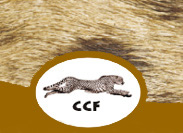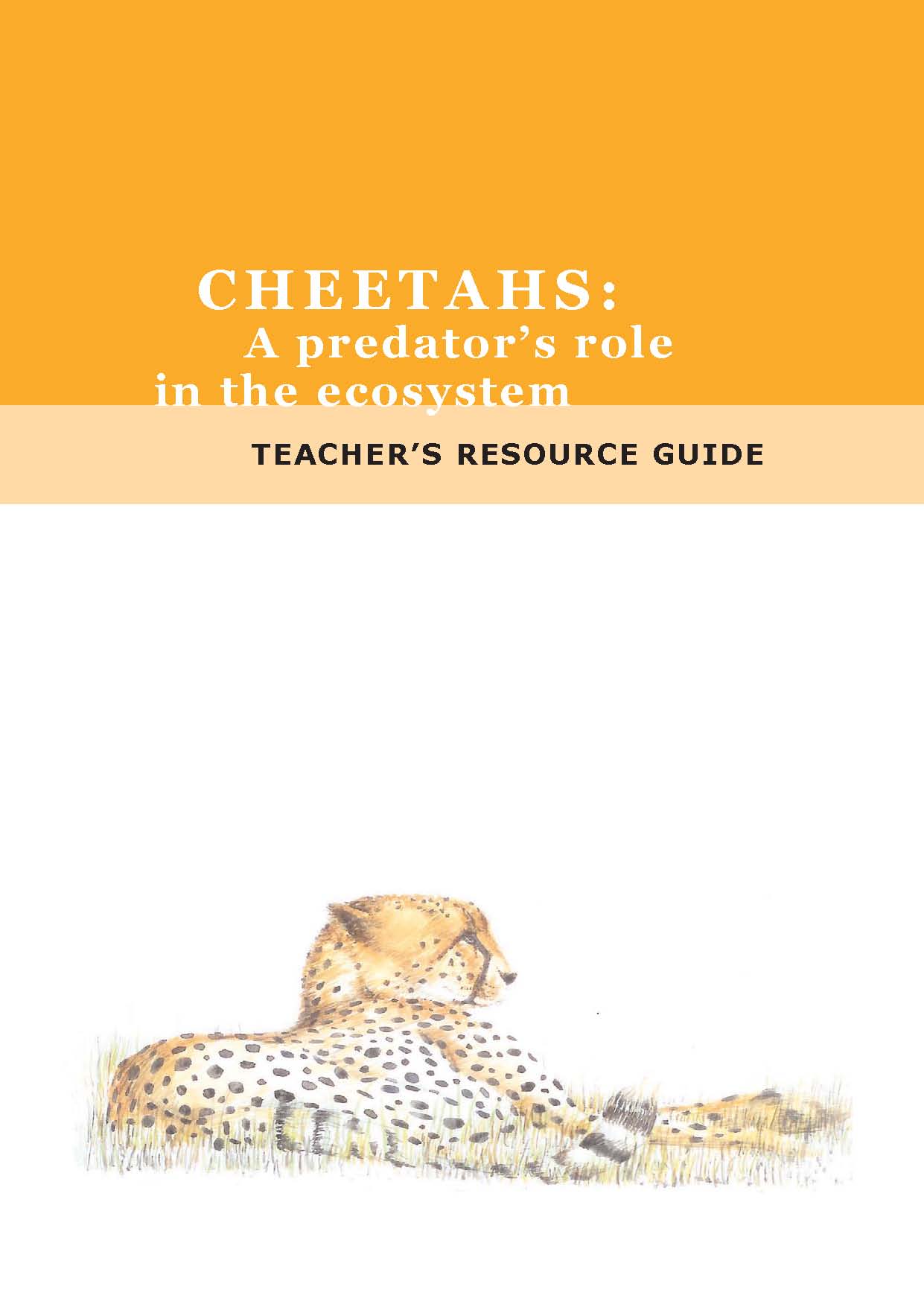

l
Cheetahs: A Predator's Role in the Ecosystem
 |
Teacher's Resource Guide |
The entire Teacher's Resource Guide is available for use in the classroom. All lessons and activities are combined into sections as .pdf files.
Cover
(Front Cover, Back Cover) , (<1MB)
Introduction (307 KB)
Cheetah Biology (entire section, 1.5 MB)
Cat Comparisons I - Learners will study the cheetah
by comparing and contrasting it to other members of the cat family. Activities
include making a cat family tree and a cat comparison card game.
Cat Comparisons II - This activity is designed to reinforce
the differences between the cats. Learners will track the lion, leopard,
cheetah, caracal, tiger and domestic cat through a simulated habitat,
learning about each individual animal as they progress through the activity.
They will also learn how to use and design field guides of their own.
Adaptations - In this activity learners will learn about
the adaptations of animals and the role those adaptations play in their
survival. Cheetah adaptations are discussed using analogous objects and
learners are given the opportunity to discover adaptations of backyard
insects.
Life Cycles - In this activity learners will work on
their graphing skills by comparing the increase in weight after birth
of cheetah cubs and human children.
Nutrition - Learners will discover what the teeth of
an animal can tell us about the animal and they will use this information
to group common animals.
Ecology (entire section, 2.7 MB)
Habitats I - The learners will become familiar with
the factors that influence an organism's habitat, including food, water,
shelter, and space. They will then apply their knowledge to themselves
and other living organisms to draw comparisons.
Habitats II - This activity will further investigate
the factors that influence an animal's habitat. It also uses the learner's
background knowledge on the major cat species to predict the best habitat
for each.
Animal Behaviors - This activity is designed as an introduction
to animal behaviours using the cheetah as a focus. Classroom and outdoor
activities introduce the topic of behaviour to the learners while the
activity ends with a research project comparing the interactions of cheetahs
and other animals sharing their environment.
Food Chains - In this activity learners study food chains,
webs, and pyramids in relation to the cheetah. They use this information
to construct their own food pyramid.
Cheetah Hunt - In this activity learners discover limiting
factors and carrying capacity using a game in which they all play cheetahs
competing in the savannah.
Predator-Prey Relationships - The purpose of this activity
is to simulate the interactions between cheetahs and gazelles in order
to understand what happens to the population of both species.
Population Change - In this activity learners will look
at which factors influence a population, including food, shelter, and
space. They will play a game which simulates a population of cheetahs
competing for food, shelter, and space. The data will then be graphed.
Conservation
(entire section, 425 KB)
The Genetic Bottleneck - This activity demonstrates
the importance of genetic diversity in healthy populations by simulating
a genetic bottleneck event.
Cheetah: An Animal at Risk - In this activity learners
will look at the main reasons many animals become endangered. They will
then look specifically at reasons why the cheetah is at risk and what
will need to be done to save the cheetah.
Threats to Survival - This role play is designed to begin
the discussion on possible solutions to the cheetah's decrease in population.
Other
Subjects (entire section, 1.2 MB)
Cheetah Math (Mathematics) - This activity includes
possible mathematics problems that centre on the cheetah. Topics include
number facts, averages, unit conversions, fractions, percentages, acceleration,
and velocity.
How Fast is the Cheetah? (Physical Education) - The learners
will develop an appreciation for the cheetah's unique adaptations and
amazing speed by comparing their speed to its.
Writing About Cheetahs (English) - These activities are
designed to develop language skills and to help learners realize their
relationship with nature through creative writing and thinking.
Mapping the Cheetah (Social Studies) - These activities
deal with the distribution of the remaining cheetah populations throughout
Africa and Asia. Learners are asked to get specific information from world
and local maps concerning geography and the location of human and cheetah
populations.
Cheetahs Through History (Social Studies) - Learners
will discover the prehistoric history of the cheetah and its movement
from North America to its present home in Africa. An activity to create
a timeline of cheetah history is also included.
Reference
(entire section, 2.5MB)
Fact Sheets:Cheetah Fact Sheet - Provides detailed information
on the cheetah.
Fact Sheets on Other Big Cats - Provides facts on the
leopard, lion, caracal, and tiger.
CCF Fact Sheet - Provides information on the founding
of the Cheetah Conservation Fund as well as details on our goals.
A Place for Predators - Discusses the importance of having
predators in a healthy ecosystem.
A Singular Species: Why Does the Cheetah Lack Genetic Diversity?
- Discusses information on the lack of genetic diversity within
the cheetah population and ways in which scientists are working to maintain
as diverse a population as possible.
The Cheetah's History - Provides information on the evolutionary
history and history with humans of the cheetah.
Cheetah Speed - Provides information on the speed of
the cheetah and its special adaptations which make it the fastest land
animal.
Cheetahs and Farmers - Provides information on the conflict
between cheetahs and farmers as well as possible solutions to the problem.
Cats of the World - A map showing the wild cats of the
world.
Why Do Species Become Endangered? - A poster which details
the H.I.P.P.O. dilemma.
Photographs of the Big Cats - Included are full-page
photographs of the cheetah, lion, leopard, tiger, and caracal for use
in teaching.
Glossary - A detailed glossary or vocabulary list of
commonly used words throughout the activity book.
